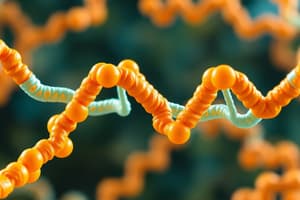Podcast
Questions and Answers
Which of the following statements about nutritionally essential amino acids is true?
Which of the following statements about nutritionally essential amino acids is true?
- They can be synthesized by the body.
- They must be obtained from the diet. (correct)
- They have no role in protein synthesis.
- They are exclusively hydrophobic.
What characteristic distinguishes an amino acid's side chain from its backbone structure?
What characteristic distinguishes an amino acid's side chain from its backbone structure?
- Side chains determine the amino acid's properties. (correct)
- Side chains are always charged.
- Side chains are unaffected by pH changes.
- Side chains contain only carbon atoms.
Which amino acid is considered aromatic?
Which amino acid is considered aromatic?
- Tyrosine (correct)
- Lysine
- Glutamic acid
- Leucine
In the context of amino acid metabolism, what role do zwitterions play?
In the context of amino acid metabolism, what role do zwitterions play?
How do amino acids contribute to buffering functions in the body?
How do amino acids contribute to buffering functions in the body?
Which of the following statements about essential amino acids is true?
Which of the following statements about essential amino acids is true?
Which part of the amino acid structure is responsible for its unique properties?
Which part of the amino acid structure is responsible for its unique properties?
What is the primary role of amino acids in protein synthesis?
What is the primary role of amino acids in protein synthesis?
Which of the following correctly describes non-polar amino acids?
Which of the following correctly describes non-polar amino acids?
What specific role do amino acids serve in the metabolic pathways?
What specific role do amino acids serve in the metabolic pathways?
How do amino acids function as buffers in biological systems?
How do amino acids function as buffers in biological systems?
Which amino acid is unique in its absence of a chiral center?
Which amino acid is unique in its absence of a chiral center?
Which of the following statements about polar amino acids is incorrect?
Which of the following statements about polar amino acids is incorrect?
Which of the following amino acids contains a hydroxyl group (-OH)?
Which of the following amino acids contains a hydroxyl group (-OH)?
What property is associated with the amino acid Histidine at a pH greater than 6?
What property is associated with the amino acid Histidine at a pH greater than 6?
Which group of amino acids is classified as basic due to their side chains?
Which group of amino acids is classified as basic due to their side chains?
Which amino acids are classified as non-polar due to their hydrophobic side chains?
Which amino acids are classified as non-polar due to their hydrophobic side chains?
Which of the following amino acids can form disulfide bonds in proteins?
Which of the following amino acids can form disulfide bonds in proteins?
Which amino acid acts as a precursor for nitric oxide synthesis in the body?
Which amino acid acts as a precursor for nitric oxide synthesis in the body?
Which statement correctly describes the role of amino acids in protein synthesis?
Which statement correctly describes the role of amino acids in protein synthesis?
Which amino acids are considered essential because they cannot be synthesized by the body?
Which amino acids are considered essential because they cannot be synthesized by the body?
What is the primary function of buffer amino acids such as Histidine?
What is the primary function of buffer amino acids such as Histidine?
How does the presence of electronegative atoms like O and N affect amino acids?
How does the presence of electronegative atoms like O and N affect amino acids?
Which amino acid is required for the synthesis of hormones and neurotransmitters?
Which amino acid is required for the synthesis of hormones and neurotransmitters?
What charge does Aspartate carry at physiological pH?
What charge does Aspartate carry at physiological pH?
Which of the following amino acids has an amide functional group?
Which of the following amino acids has an amide functional group?
Which amino acid contributes to the formation of a buffer system in the human body?
Which amino acid contributes to the formation of a buffer system in the human body?
Flashcards
Amino Acid Structure
Amino Acid Structure
Amino acids are organic compounds containing both an amino group (-NH2) and a carboxyl group (-COOH).
Amino Acid Side Chains
Amino Acid Side Chains
Different amino acids have unique side chains (R groups) affecting their chemical properties.
Amino Acid Properties
Amino Acid Properties
Properties include polarity (polar/nonpolar), charge (acidic/basic), and pKa values.
Essential Amino Acids
Essential Amino Acids
Signup and view all the flashcards
Amino Acid Classification
Amino Acid Classification
Signup and view all the flashcards
Side Chain (R group)
Side Chain (R group)
Signup and view all the flashcards
Hydrophobic Amino Acids
Hydrophobic Amino Acids
Signup and view all the flashcards
Polar Amino Acids
Polar Amino Acids
Signup and view all the flashcards
Acidic Amino Acids
Acidic Amino Acids
Signup and view all the flashcards
Basic Amino Acids
Basic Amino Acids
Signup and view all the flashcards
Histidine (His)
Histidine (His)
Signup and view all the flashcards
Serine (Ser), Threonine (Thr), Tyrosine (Tyr)
Serine (Ser), Threonine (Thr), Tyrosine (Tyr)
Signup and view all the flashcards
Asparagine (Asn), Glutamine (Gln)
Asparagine (Asn), Glutamine (Gln)
Signup and view all the flashcards
Cysteine (Cys)
Cysteine (Cys)
Signup and view all the flashcards
Phenylalanine (Phe), Tyrosine (Tyr), Tryptophan (Trp)
Phenylalanine (Phe), Tyrosine (Tyr), Tryptophan (Trp)
Signup and view all the flashcards
Methionine (Met)
Methionine (Met)
Signup and view all the flashcards
Aspartic Acid (Asp)
Aspartic Acid (Asp)
Signup and view all the flashcards
Glutamic Acid (Glu)
Glutamic Acid (Glu)
Signup and view all the flashcards
Arginine (Arg), Lysine (Lys)
Arginine (Arg), Lysine (Lys)
Signup and view all the flashcards
What makes up proteins?
What makes up proteins?
Signup and view all the flashcards
What's special about amino acids?
What's special about amino acids?
Signup and view all the flashcards
What are the different parts of an amino acid?
What are the different parts of an amino acid?
Signup and view all the flashcards
What makes amino acids unique?
What makes amino acids unique?
Signup and view all the flashcards
What are some of the properties of amino acids?
What are some of the properties of amino acids?
Signup and view all the flashcards
Why are some amino acids essential?
Why are some amino acids essential?
Signup and view all the flashcards
How do amino acids contribute to life?
How do amino acids contribute to life?
Signup and view all the flashcards
What happens when you don't get enough of essential amino acids?
What happens when you don't get enough of essential amino acids?
Signup and view all the flashcards
Study Notes
Marks' Basic Medical Biochemistry
- This is a textbook on basic medical biochemistry, intended as a clinical approach.
- It is in its 5th edition.
- The authors are Michael Lieberman and Alisa Peet.
- The publisher is Wolters Kluwer.
Amino Acid and Protein
- Amino acids are the building blocks of proteins.
- Proteins are essential for all life processes, including growth, digestion, feeding, DNA replication, and movement.
- Every body part contains proteins.
Properties of Amino Acids
- General properties: amino acids have an amino group, a carboxyl group, a chiral carbon, and an R-group.
- Side-chain properties: amino acids have different side chains, which can be grouped into non-polar, aliphatic; uncharged polar; acidic, basic.
- Nutritionally essential amino acids: nine amino acids that cannot be synthesized in the body and must be obtained from the diet. Examples include phenylalanine, valine, tryptophan, threonine, isoleucine, methionine, histidine, leucine, and lysine. Some amino acids are also considered semi-essential, meaning they are essential during growth.
General Structure of an Amino Acid
- Amino group (+H₃N)
- Carboxyl group (-COOH)
- Chiral carbon
- R-group: a side chain (20 different types)
Configurations of Amino Acids (L and D)
- L-amino acids are predominantly found in proteins.
- D-amino acids are found in certain organisms and peptides.
Side Chain Properties (Grouping)
- Non-polar, aliphatic
- Uncharged polar
- Acidic
- Basic
- Sulfur-containing
- Aromatic ring containing (two or more categories)
Non-polar (Hydrophobic) amino acids
- Include valine, isoleucine, leucine, methionine, phenylalanine, tryptophan, alanine, proline, and glycine.
- Hydrophobic, meaning they avoid water.
- Often found embedded in cell membranes.
Uncharged polar amino acids
- Include serine, threonine, tyrosine, asparagine, glutamine, cysteine, and histidine.
- Water-soluble due to hydroxyl (-OH) or amide (-NH₂) groups.
- Many are involved in phosphorylation, a vital cellular process.
Acidic and Basic amino acids (charged amino acids)
- Includes Aspartate, Glutamate, Arginine, Lysine, and Histidine.
- Acidic amino acids have negatively charged side chains (Asp, Glu).
- Basic amino acids have positively charged side chains (Arg, Lys, His).
Sulfur-containing amino acids
- Include methionine and cysteine.
- Cysteine has a thiol group (-SH), that can form disulfide bonds, which are crucial for protein structure.
Aromatic ring amino acids
- Include phenylalanine, tyrosine, and tryptophan.
- The aromatic rings give these amino acids unique properties.
Nutritionally Essential Amino Acids
- Nine essential amino acids that the body cannot synthesize and must be obtained from the diet.
- Examples include phenylalanine, valine, tryptophan, threonine, isoleucine, methionine, histidine, leucine, and lysine. Also, histidine is semi-essential.
Conditional Essential Amino Acids
- Amino acids that are essential under specific conditions (e.g., disease states or rapid growth).
- Examples include cysteine, tyrosine, arginine, proline, and glycine.
Quality of Dietary Protein
- The quality of protein depends on the presence of essential amino acids in adequate amounts.
- Animal proteins (meat, milk, eggs) generally contain all essential amino acids.
Kwashiorkor and Marasmus
- Kwashiorkor is a disease caused by a protein deficiency.
- Marasmus is a disease resulting from inadequate intake of protein and energy.
- Symptoms and signs are shown (distended abdomen, swollen ankles, wrinkled/scaly skin, etc).
MCQ True/False Questions
- Provided a collection of true/false questions about amino acids.
Summary of Amino Acids
- Hierarchical outline representing amino acids with a main classification structure (general structure, side chain properties, acid-base properties, list of essential, conditional amino acids) to help understand the characteristics of amino acids.
Studying That Suits You
Use AI to generate personalized quizzes and flashcards to suit your learning preferences.




